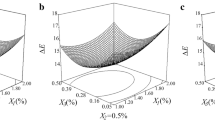Abstract
Inhibition of melanosis was studied in pink shrimp (Parapenaeus longirostris) treated on shipboard with various concentrations of 4-hexylresorcinol (4-HR)-based formulations. Treatments, applied by dipping and dusting, were carried out at sea immediately following the catch. A selection of the most effective treatments was made to determine the level of 4-HR residues in the muscle and viscera. 4-Hexylresorcinol proved effective at extending shelf-life over that of untreated shrimp at all the concentrations tested. However, the minimum dose of 4-HR to avoid melanosis for at least one week was found to be 0.5%, with a residual level in muscle ranging from ≈80 to 90 mg/kg at day 2 of storage to >200 mg/kg after 7 days. Residues around 2–3 mg/kg were shown to be effective to prevent melanosis in pink shrimp only for 2 days from a commercial point of view.




Similar content being viewed by others
References
McEvily AJ, Iyengar R, Otwell S (1991) Food Technol 45(9):80–86
Otwell WS, Iyengar R, McEvily AJ (1992) J Aquat Food Product Technol 1(1):53–65
Guandalini E, Ioppolo A, Mantovani A, Stacchini P, Giovannini C (1998) Food Addit Contam 15(2):171–180
Montero P, López-Caballero ME, Pérez-Mateos M (2001) J Food Sci 66(8):1201–1206
Slattery SL, Williams DJ, Cusach A (1995) Food Aust 47(11):509–514
Montero P, Martínez-Alvarez O, Gómez-Guillén MC (2004) J Food Sci 68(8):643–647
Ogawa M, Perdigão NB, Santiago ME, Kozima TT (1984) Nippon Suisan Gakkaishi 50:1763–1769
Smallwood AW, Ranieri TL, Satzger RD (1998) J AOAC Int 81(2):488–491
Anonymus (2004) Proposal for a Directive of the European Parliament and of the Council amending Directive 95/2EC on food additives other than colours and sweeteners and Directive 94/35/EC on sweeteners for use in foodstuffs. Commission of the European Communities. Brussels, 11.10.2004. COM(2004)650 final. 2004/0237 (COD).
Acknowledgements
This work was funded by the Consejería de Agricultura y Pesca, Junta de Andalucía [Department of Agriculture and Fisheries of the Autonomous Government of Andalusia] (Project 110105030020)
Author information
Authors and Affiliations
Corresponding author
Rights and permissions
About this article
Cite this article
Montero, P., Martínez-Álvarez, O., Zamorano, J.P. et al. Melanosis inhibition and 4-hexylresorcinol residual levels in deepwater pink shrimp (Parapenaeus longirostris) following various treatments. Eur Food Res Technol 223, 16–21 (2006). https://doi.org/10.1007/s00217-005-0080-4
Received:
Accepted:
Published:
Issue Date:
DOI: https://doi.org/10.1007/s00217-005-0080-4




